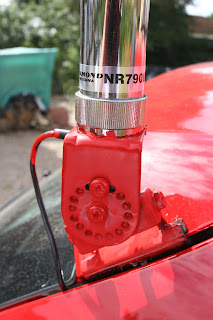 |
| The main HF Windom attaches to the pole seen on the right-hand side |
If you notice, there are other poles sticking up above the small flat roof that my wife & I have. Looking at the white fibreglass aerial 'nearest' the TV aerial on the chimney, you can see my main 2m (145MHz) & 70cms (433MHz) aerial:
X510HDN Base Antenna | |
| Specifications: | |
| Band: | 2m/70cm |
| Element Phasing: | 3-5/8l/8-5/8l |
| Gain (dB): | 8.3/11.7 |
| Watts: | 330 (2m) / 250 (70cm) |
| Connector: | Type-N |
| Weight: | 5 lbs. |
| Length: | 17.2' |
| Max Wind Resistance: | 90 MPH |
It is really an effective aerial and the coverage is phenomenal from up here! I am really pleased with this.
 |
| X510HDN Base Antenna is the white 'stick' on the right hand side. |
The pole to the left of the X510HDN holds a 10m (28>29MHz) fibreglass aerial for DX and Ground Wave working. When conditions are right, I use this aerial for 10m FM DX (long distance) contacts. Very efficient, with no measurable reflective power ~ so all power from the radio is effectively radiated from the aerial itself. All feeder cable to my aerials are 'top-notch' military UHF (Ultra High Frequency) 'spec' ~ which is overkill for the 10m band, but there is minimal loss through the cable!
Finally, the pole on the left-hand side of the photo above shows a 3-element 6m (50MHz) horizontal beam, on top of a rotator, allowing me to turn the aerial to face DX stations around the World. Above it is a V2000A Tri-band Base Antenna:
| Specifications: | |
| Bands: | 6m/2m/70cm |
| Frequency (MHz): | 52-54/144-148/440-450 |
| Gain: | 2.15dBi/6.2dB/8.4dB |
| Impedance (nominal): | 50W |
| VSWR: | 1.5:1 (typical) |
| Power Rating: | 150 watts |
| Element Phasing: | 1/2l/2-5/8l/4-5/8l |
| Max Wind Rating: | 112 m.p.h. |
| Mast Dia. Acceptance: | 1.2 to 2.4 inches |
| Length/Weight | 8.3 ft./2.6 lbs. |
| Connector: | SO-239 Female |
This, again, is a very efficient aerial ~ one that I use for 'local' nattering on 6m / 2m / 70cms!
 |
| Hanging just this side of the Kent Cobnut Tree is the white centre balun of the HF Windom Aerial. |
The other end of the Windom aerial is held aloft by the use of an ex-military high-grade aluminium telescopic mast.
 |
| The telescopic pole can be seen extended just beyond the white reclining seat. |
So there we have it! Ready for the Winter ahead! Here's hoping for some choice contacts on the Amateur Radio bands.






